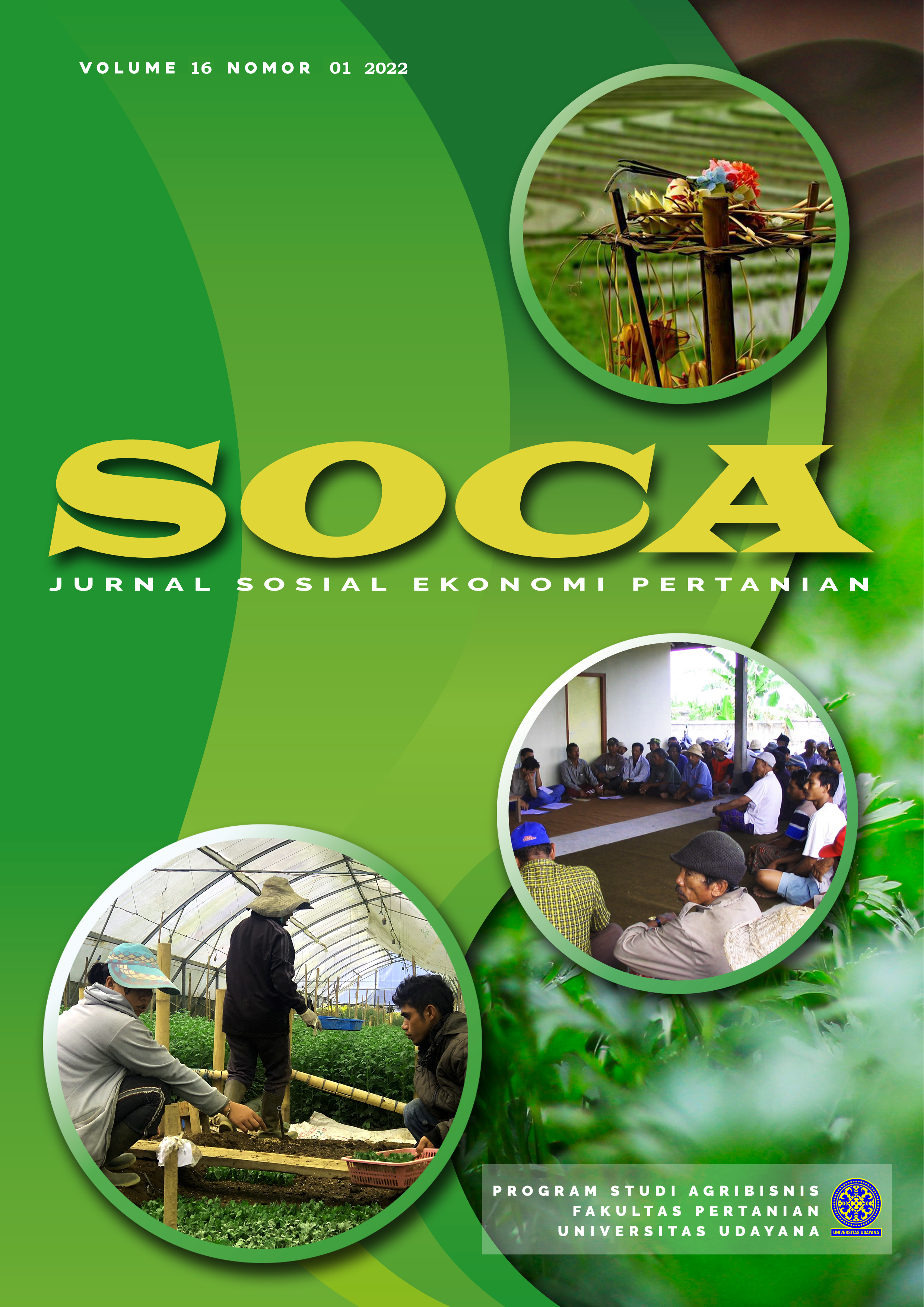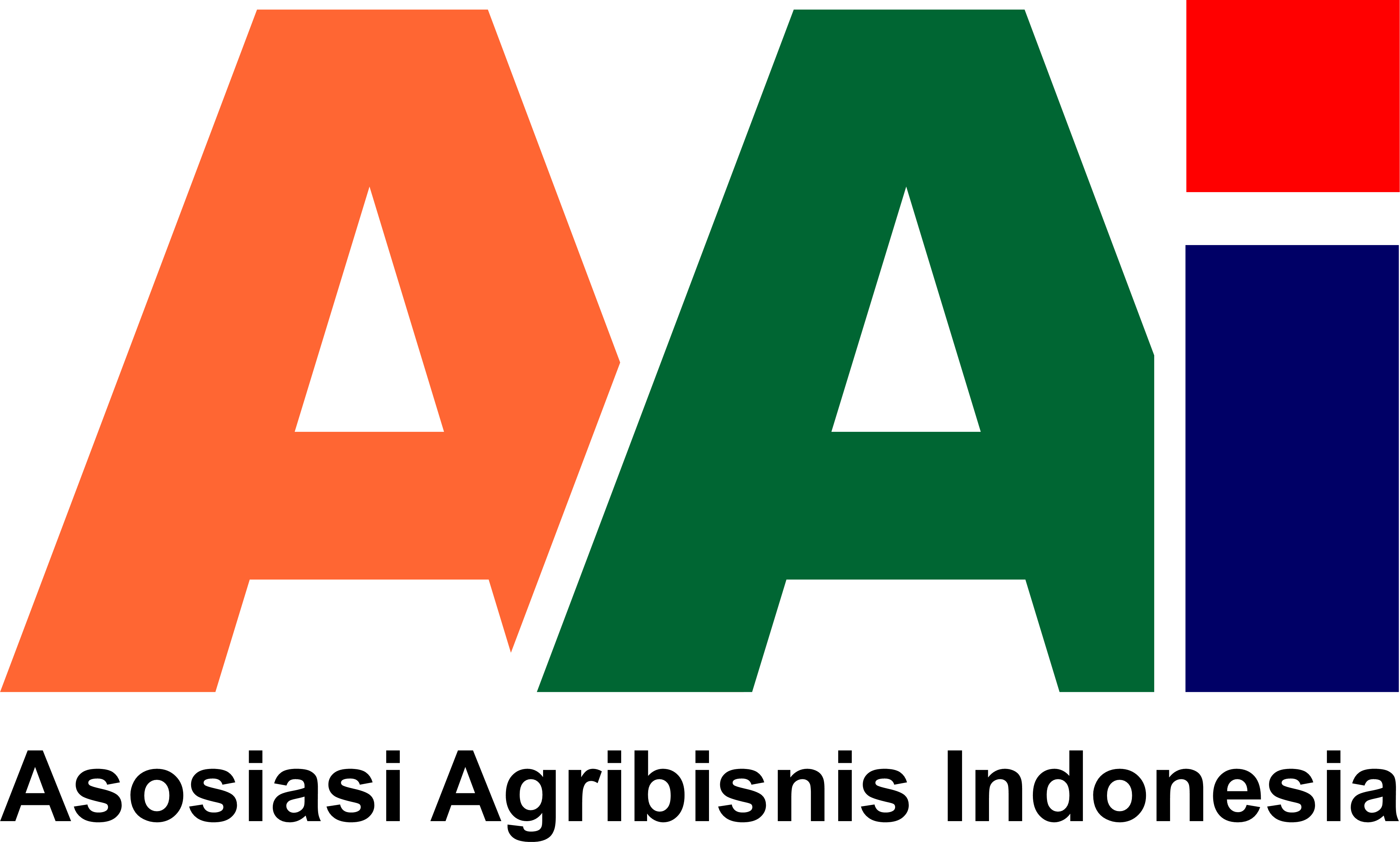Competitiveness of Indonesian Tea Export in Southeast Asia Markets
Abstract
Tea is a popular export commodity from Indonesia. It has been exported worldwide, especially to Southeast Asia countries. However, the popularity of the tea export market attracts export competitors, which in turn served a strenuous chance to win in the market. The objective of the study was to analyze the competitiveness and factors that affected the exported Indonesian tea in Southeast Asia Market. The data analysis method applied was the Revealed Comparative Advantage (RCA), Trade Specialization Ratio (TSR), and data panel regression (Fixed-Effect Model). Findings showed that exported Indonesian tea had a strong level of comparative competitiveness. Analysis revealed that Indonesia tended to be a tea exporter on the export expansion stage. The real GDP of the countries of destination, exported tea price, the population of the countries of destination, and RCA index had delivered significant influence for the exported volume of Indonesian tea to the Southeast Asia countries.
Downloads
References
Alvianti, A., & Pazli. (2017). Upaya PT. Perkebunan Nusantara VIII dalam mengembangkan ekspor teh hitam ke Malaysia. Jurnal Online Mahasiswa Fakultas Ilmu Sosial Dan Ilmu Politik Universitas Riau, 4(2), 1–13.
Amoro, G., & Shen, Y. (2013). The Determinants of Agricultural Export : Cocoa and Rubber in Cote d ’ Ivoire. International Journal of Economics and Finance, 5(1), 228–233. https://doi.org/10.5539/ijef.v5n1p228
Anwar, A., Siddique, M., Dogan, E., & Sharif, A. (2020). The moderating role of renewable and non-renewable energy in environment-income nexus for ASEAN countries: Evidence from Method of Moments Quantile Regression. Renewable Energy, 164(2021), 956–967. https://doi.org/10.1016/j.renene.2020.09.128
Badan Pusat Statistik [BPS]. 2020. Indikator Pertanian 2019. Badan Pusat Statistik, Jakarta. Tersedia pada: https://www.bps.go.id/publication/2020/11/30/a5f6025eb90c86561ce449e0/indikator-pertanian-2019.html.
Badan Pusat Statistik [BPS]. 2020. Pendapatan Nasional Indonesia 2015-2019. Badan Pusat Statistik, Jakarta. Tersedia pada: https://www.bps.go.id/publication/2020/06/12/7fe8d749c43bad46b1601662/pendapatan-nasional-indonesia-2015-2019.html
Balassa, B. (1965). Trade Liberalisation and “ Revealed ” Comparative Advantage. The Manchester School, 33(2), 99–123. https://doi.org/10.1111/j.1467-9957.1965.tb00050.x
Boansi, D., Odilonkounagbélokonon, B., & Appah, J. (2014). Determinants of Agricultural Export Trade : Case of Fresh Pineapple Exports from Ghana. British Journal of Economics, Management & Trade, 4(11), 1736–1754. https://doi.org/10.9734/BJEMT/2014/10773
Braha, K., Qineti, A., Cupák, A., & Lazorcáková, E. (2017). Determinants of Albanian agricultural export: The gravity model approach. Agris On-Line Papers in Economics and Informatics, 9(2), 3–21. https://doi.org/10.7160/aol.2017.090201
Brilliantina, A., B.H.Purnomo, & I.B.Suryaningrat. (2019). Dynamic System Model for Performance Measurement of Tea Agroindustry. IOP Conf. Series: Earth and Environmental Science. https://doi.org/10.1088/1755-1315/411/1/012015
Brueckner, M., Dabla-Norris, E., Gradstein, M., & Lederman, D. (2017). The Rise of the Middle Class and Economic Growth in ASEAN by. Journal of Asian Economics, 56(2018), 48–58. https://doi.org/10.1016/j.asieco.2017.12.008
Direktorat Jenderal Perkebunan [Ditjenbun]. 2019. Statistik Perkebunan Indonesia. Jakarta. Tersedia pada: http://ditjenbun.pertanian.go.id/?publikasi=buku-publikasi-statistik-2018-2020
Djoni, Darusman, D., Atmaja, U., & Fauzi, A. (2013). Determinants of Indonesia ’ s Crude Coconut Oil Export Demand. Journal Ef Economics and Sustainable Development, 4(14), 98–106.
Ginting, A. M. (2013). The Influence of Exchange Rate on Indonesia’s Exports. Buletin Ilmiah Litbang Perdagangan, 7(1), 1–18. https://doi.org/10.30908/bilp.v7i1.96
Gujarati, D. N., & Porter, D. C. (2012). Dasar-dasar Ekonometrika (5th ed.). McGraw-Hill dan Salemba Empat.
Hong, N. B., & Yabe, M. (2015). Resource Use Efficiency of Tea Production in Vietnam: Using Translog SFA Model. Journal of Agricultural Science, 7(9), 160–172. https://doi.org/10.5539/jas.v7n9p160
Inayah, I., Oktaviani, R., & Daryanto, H. K. (2016). The Analysis of Export Determinant of Indonesian Pepper in the International Market. International Journal of Scicence and Research (IJSR), 5(11), 1856–1860. https://doi.org/10.21275/ART20163261
Kaneko, Y., & Yanagi, E. (1988). International Comparison of Export Competitiveness for Industrial Products in East Asian Countries. Asian Economic Journal, 2(1), 91–111. https://doi.org/10.1111/j.1467-8381.1988.tb00121.x
Kannan, M. (2013). The determinants of production and export of natural rubber in India. IOSR Journal of Economics and Finance, 1(4), 13–20. https://doi.org/10.9790/5933-0154145
Kementerian Keuangan Republik Indonesia. 2017. Peraturan Menteri Keuangan Republik Indonesia nomor 6/PMK.010/2017 Tentang Penetapan Sistem Klasifikasi Barang Dan Pembebanan Tarif Bea Masuk Atas Barang Impor. Tersedia pada: https://jdih.kemenkeu.go.id/fulltext/2017/6~PMK.010~2017Per.pdf
Lee, J., Chambers, E., Chambers, D. H., Chun, S. S., Oupadissakoon, C., & Johnson, D. E. (2010). Consumer acceptance for green tea by consumers in the United States, Korea and Thailand. Journal of Sensory Studies, 25(2010), 109–132. https://doi.org/10.1111/j.1745-459X.2010.00287.x
Lero, O. R., Pudjiastuti, A. Q., & Sumarno. (2020). Factors Influencing Indonesia’s Cashew Export Volume. Agriekonomika, 9(2), 205–214. https://doi.org/10.21107/agriekonomika.v9i2.8524 Agriekonomika
Mankiw, N. G. (2016). Principle Of Macroeconomics (8th ed.). Worth Publishers.
Mwinuka, L., & Mlay, F. (2015). Determinants and performance of sugar export in Tanzania. Journal of Finance and Economics, 3(1), 6–14. https://doi.org/10.12691/jfe-3-1-2
Nachrowi, D., & Usman, H. (2006). Pendekatan Populer dan Praktis Ekonometrika untuk Analisis Ekonomi dan Keuangan. Badan Penerbit Universitas Indonesia.
Narmada, I. B., Sarasati, A., Wicaksono, S., Rezkita, F., Putra Wibawa, K. G., Hayaza, S., & Nugraha, A. P. (2020). Phytochemical screening, antioxidant activity, functional groups and chemical element characterization analysis of (-)-Epigallocatechin-3Gallate (EGCG) in East Javanese green tea methanolic extract: An experimental in vitro study. Systematic Reviews in Pharmacy, 11(5), 511–519. https://doi.org/10.31838/srp.2020.5.68
Ng, T. P., Gao, Q., Gwee, X., & Chua, D. Q. L. (2021). Tea consumption and Depression from follow up in the Singapore Longitudinal Ageing Study. Journal of Nutrition, Health and Aging, 25(3), 295–301. https://doi.org/10.1007/s12603-020-1526-x
Nugraha, I. J., Wastra, A. R., & Ichdayati, L. I. (2016). Pemasaran produk teh celup hijau walini pada industri hilir teh PT Perkebunan Nusantara VII, Bandung, Jawa Barat. Jurnal Agribisnis, 10(1), 117–132.
Nugrahaningrum, Y., Zakaria, R., & Fahma, F. (2020). Analysis of Indonesian tea competitiveness in the international market. AIP Conference Proceedings, 2217(April). https://doi.org/10.1063/5.0000810
Oktaviana, N., Masyhuri, M., & Hartono, S. (2016). Competitiveness of Tea Exports in Asean: A Constant Market Share Analysis. Ilmu Pertanian (Agricultural Science), 1(2), 88–93. https://doi.org/10.22146/ipas.10662
Parkin, M. (2012). Macroeconomics (10th ed.). Pearson Education.
Perdana, P., Darwanto, D. H., & Jamhari. (2015). Daya Saing Ekspor Cengkeh Indonesia di Pasar Internasional [Universitas Gadjah Mada]. http://etd.repository.ugm.ac.id/home/detail_pencarian/91063
Pusat Data dan Sistem Informasi Pertanian [Pusdatin]. 2019. Buku Outlook Komoditas Perkebunan Teh. Kementerian Pertanian, Jakarta. Tersedia pada: http://epublikasi.pertanian.go.id/arsip-outlook/75-outlook-perkebunan/698-outlook-teh-2019
Quansah, K. A., & Ahn, W. C. (2017). The Effect of the Korea-Australia Free Trade Agreement ( KAFTA ) on the Korea-Australia Trade Structure. The Asian Journal of Shipping and Logistics, 33(4), 229–235. https://doi.org/10.1016/j.ajsl.2017.12.006
Ramadhani, F. (2013). Daya saing teh Indonesia di pasar internasional. Economics Development Analysis Journal, 2(4), 468–475. https://doi.org/doi.org/10.15294/edaj.v2i4.3214
Rossato, F. G. F. S., Susaeta, A., Adams, D. C., Hidalgo, I. G., de Araujo, T. D., & de Queiroz, A. (2018). Comparison of revealed comparative advantage indexes with application to trade tendencies of cellulose production from planted forests in Brazil, Canada, China, Sweden, Finland and the United States. Forest Policy and Economics, 97(2018), 59–66. https://doi.org/10.1016/j.forpol.2018.09.007
Shannon, A.K, E. J., & N, A. (2017). Polyphenolic content and antioxidant capacity of white, green, black, and herbal teas: a kinetic study. Food Research, 2(1), 1–11. https://doi.org/10.26656/fr.2017.2(1).117
Sugiharti, L., Purwono, R., & Esquivias, M. A. (2020). Analysis of determinants of indonesian agricultural exports. Entrepreneurship and Sustainability Issues, 7(4), 2676–2695. https://doi.org/10.9770/jesi.2020.7.4(8)
Sumadio, W., Andriesse, E., Aprilianti, F., & Sulyat, A. (2017). Droughts and debts : The domestic tea value chain and vulnerable livelihoods in Girimukti village , West Java , Indonesia. Journal of Agriculture and Rural Development in the Tropics and Subtropics, 118(1), 69–80.
Trademap, 2021. Trade Statistics for International Business Development. Tersedia pada: https://www.trademap.org
United Nations Commodity Trade Statistic [UN Comtrade]. International Trade Statistic Database 2020. Tersedia pada: https://www.un.comtrade.org/data
Tesfaye, E. (2014). Determinants of Agricultural Export in Sub- Saharan Africa : Evidence from Panel Study. Page 62 American Journal of Trade and Policy, 1(2), 62–70. https://doi.org/10.18034/ajtp.v1i2.364
Verter, N., & Bečvářová, V. (2014). Analysis of some drivers of cocoa export in Nigeria in the era of trade liberalization. Agris On-Line Papers in Economics and Informatics, 6(4), 208–218. https://doi.org/10.22004/ag.econ.196590
Vinayak, H., Thompson, F., & Tonby, O. (2014). Understanding ASEAN: Seven things you need to know (Issue 13, pp. 1–8). McKinsey & Company. http://www.iberglobal.com/files/ASEAN_McKinsey.pdf
Voora, V., Bermúdez, S., & Larrea, C. (2019). Global Market Report : Tea. Sustainable commodities marketplace series 2019. International Institute For Sustainable Development (IISD), Canada. https://www.jstor.org/stable/resrep22027?seq=1#metadata_info_tab_contents
Wei, G., Huang, J., & Yang, J. (2012). The impacts of food safety standards on China’s tea exports. China Economic Review, 23(2), 253–264. https://doi.org/10.1016/j.chieco.2011.11.002
World Bank. 2020. World Bank Database. Tersedia pada: https://www.worldbank.org
Yu, C., & Qi, C. (2015). Research on the Complementarity and Comparative Advantages of Agricultural Product Trade between China and CEE Countries. Journal of Service Science and Management, 8(2), 201–208. https://doi.org/dx.doi.org/10.4236/jssm.2015.82022 Research
Yulhar, T. F. M., & Darwanto, D. H. (2019). Competitiveness Of Indonesian Crude Coconut Oil Export In Destination Countries. Agro Ekonomi, 30(2), 125–138. https://doi.org/10.22146/ae.49014













